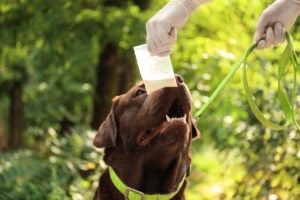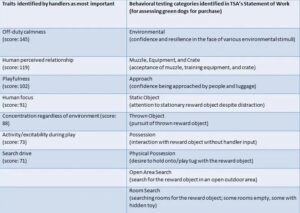
In 2014 the TSA surveyed their detection dog handlers to find out what traits in their canine partners the handlers considered important to their success as detection dogs. The goal of the study was to determine whether the traits assessed by the staff of the breeding program during the dogs’ development (using standardized assessment tools including the TSA/ACS Hunt Test) matched up with the traits handlers considered important. After analyzing the responses of the 34 handlers who completed the survey, they found that 13 of the 15 traits assessed during development were also considered important by the handlers. The study also gives us some interesting food for thought about procurement testing and dogs who are successful in the long term.
Out of 47 traits considered, seven were mentioned by the most handlers and with the most relative importance to the dogs’ success as a detection dog. The top four are not touched upon during procurement assessments. The “second tier” of traits identified in the study (lower scores than the top group but still significantly above the statistical average) included general drive regardless of environment, concentration during search, physical possession, independence during search, sociability, and athleticism. This second tier of traits more closely aligns with the traits evaluated during procurement testing.

Read the study here
Read the statement of work here

